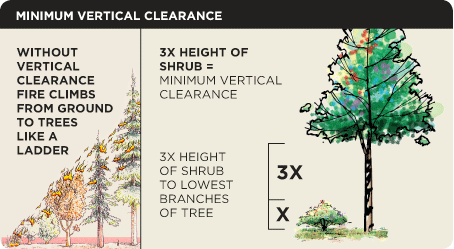|
Home Page \ LifeSafety \ Defensible Space

Defensible Space
Defensible space is the area required between a building on your property and the wildland area that surrounds it. This space creates a buffer needed to slow or halt the spread of wildfire to a structure. It protects your home from catching fire-either from direct flame contact or radiant heat. Defensible space is also important for the protection of the firefighters defending your home.

Defensible Space Zones
Two zones make up the required 100 feet of defensible space. 
Zone 1
Zone 1 extends 30 feet out from buildings, structures, decks, etc.
* Remove all dead plants, grass and weeds (vegetation).
* Remove dead or dry leaves and pine needles from your yard, roof and rain gutters.
* Trim trees regularly to keep branches a minimum of 10 feet from other trees.
* Remove branches that hang over your roof and keep dead branches 10 feet away from your chimney.
* Relocate wood piles into Zone 2.
* Remove or prune flammable plants and shrubs near windows.
* Remove vegetation and items that could catch fire from around and under decks
.
* Create a separation between trees, shrubs and items that could catch fire, such as patio furniture, wood piles, swing sets, etc.
Zone 2
* Cut or mow annual grass down to a maximum height of 4 inches.
* Create horizontal spacing between shrubs and trees. (See diagram)
* Create vertical spacing between grass, shrubs and trees. (See diagram)
* Remove fallen leaves, needles, twigs, bark, cones, and small branches. However, they may be permitted to a depth of 3 inches if erosion control is an issue.

Plant and Tree Spacing
The spacing between grass, shrubs, and trees is crucial in reducing the spread of wildfires. The spacing needed is determined by the type and size of brushes and trees, as well as the slope of the land. For example, a property on a steep slope with larger vegetation requires greater spacing between trees and shrubs than a level property that has small, sparse vegetation.
Vertical Spacing
On all trees, branches should be removed at least 6 feet from the ground.
The lack of vertical spacing can allow a fire to move from the ground to the brush to the tree tops like a ladder.
To determine the proper vertical spacing between shrubs and the lowest branches of trees, use the formula below.

Example: A five foot shrub is growing near a tree. 3x5 = 15 feet of clearance needed between the top of the shrub and the lowest tree branch.
Horizontal Spacing
Horizontal spacing is dependent on the slope of the land and the height of the shrubs or trees. Check the chart below for an estimation of spacing distances.
 |

